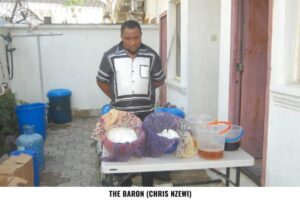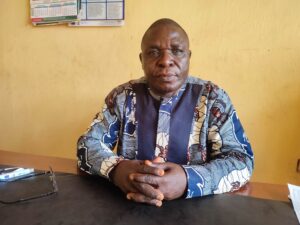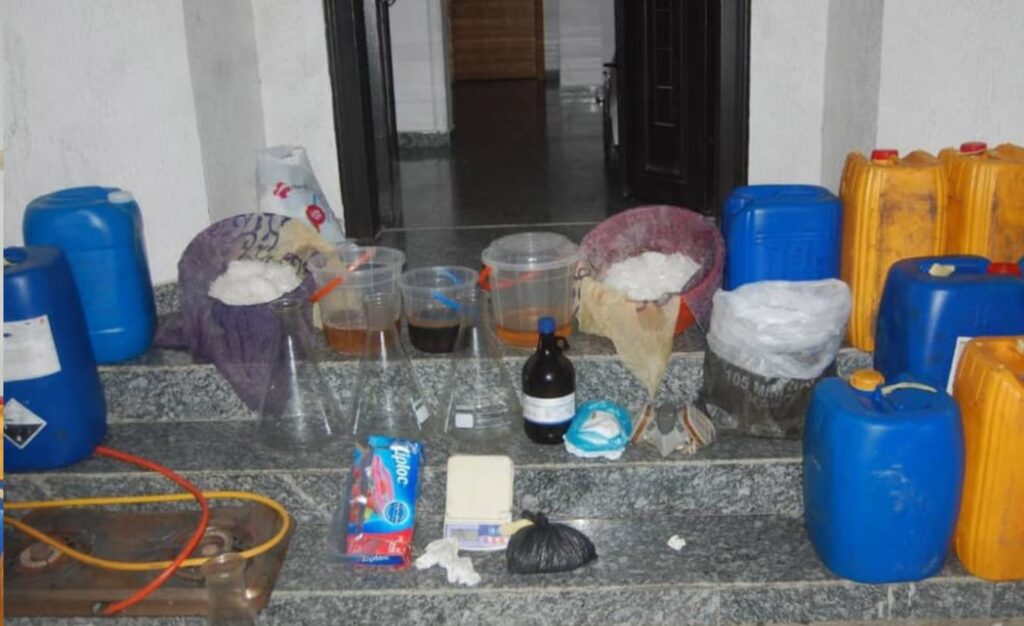By Arinze Chijioke
In November 2021, a Twitter user shared series of disturbing videos which captured moments when some young men were stripped of their cloths and had their hands and legs tied to pillars and beaten for either smoking Methamphetamine, popularly known as Mkpurummiri, or selling the substance.
In one of the videos, youths of Ebenato Ekwe, a community in Isu LGA of Imo State were heard chanting “no more dealer” as they flogged a young man — whom they claim was a dealer in Meth.
Since the last quarter of 2021, the South-East region has witnessed what is best described as methamphetamine epidemic. The site of mentally deranged able-bodied young men and women roaming the streets and muttering, with tattered cloths and barefooted most of the times, is common.
Drug trafficking and illegal laboratories are said to be the two main factors encouraging availability of the substance and its use in the region, a development which is believed to have contributed to the surge in crime rate as those who take the drugs are usually emboldened.
In October, a boy reportedly killed his father in Adazi Ani in Anambra State and took his N50, 000 to buy Mkpurummiri. He was apprehended by youths of the community, beaten to stupor and burnt alive.
This August, a 500-level student of the Michael Okpara University Of Agriculture Umudike, MOUAU, Abia State, Modestus Hyacinth Egbulefu reportedly committed suicide after he allegedly took the substance. He was said to have jumped from the 3-storey building identified as Groom Base Lodge.
Meth is not only sold or consumed by adult males alone. In Nsugbe, Oyi Local Council of Anambra State, youths arrested two young girls that sold the substance in the area. When questioned, one of them confessed that she was only helping her mother to do the business.
In February, the Ebonyi State Command of the Ebubeagu security outfit reportedly arrested a gang of 12 suspected drug smugglers who specialise in the distribution of hard drugs such as Methamphetamine, popularly known as Mkpurummiri.
About Crystal Meth
The national institute on drug abuse describes Methamphetamine as a powerful, highly addictive stimulant that affects the central nervous system which can be consumed through smoking, swallowing in the form of pills, snorting through the nose or injecting the powder after it is dissolved in alcohol or water.
The International Drug Control Conventions has since categorised Meth as Schedule II (i.e., “drugs with a high potential for abuse, with use, potentially leading to severe psychological or physical dependence”).
While its long-term effects include: extreme weight loss, addiction, severe dental problems, intense itching, leading to skin sores from scratching, anxiety, changes in brain structure and function, confusion, memory loss, sleeping problems, violent behavior, its short term effects include increased wakefulness and physical activity, decreased appetite, faster breathing, rapid and/or irregular heartbeat, increased blood pressure and body temperature.
A dangerous illicit drug which looks like ice or white chalk crystal and sometimes can be blue and can be dissolved in water, It is said to be a very addictive stimulant that renders the user hyperactive and prone to destructive tendencies, which at the extreme do not exclude suicide or homicide at the slightest provocation and without a feeling of remorse.
The manufacturing process generates toxic fumes that can harm anyone exposed to them, said assistant State Commander Drug Demand Reduction Department, NDLEA Enugu State Command, Ome Ajayi.
“The substance is often being manufactured in clandestine laboratories and usually harmful to those living close to the labs. “While those who operate the laboratories have protective equipment, those living within do not have and it makes it easy for them to be affected,” he said. “When they inhale it, it gets to the brain and affects how it functions. They also have breathing problem.”
The process also gives off extremely explosive gases. Every pound of meth can create up to 5 pounds of toxic waste that can seep into the soil and groundwater. Common pills for cold remedies are also used as the basis to produce the drug.
“The meth “cook” extracts ingredients from those pills and to increase its strength combines the substance with chemicals such as battery acid, drain cleaner, lantern fuel and antifreeze” according to a report from the Foundation for a drug free world.
According to a medical expert, Dr. Jude Onah, the drug has the capacity to affect the central nervous system of whoever takes it and creates a feeling of massive happiness that is very addictive.
“Someone with addiction to the drug can be identified by his tattered dressing and shabby looks,” he said. “It is common to see them picking their hair or skin; they also have loss of appetite and weight and are constantly moving their eyes, with strange sleeping patterns like staying up for days or even weeks at a time.”
Onah explained that apart from being unable to sleep and being violent, the substance typically makes users look older and their faces prone to acne, adding that sometimes, excessive use leads to damaged gum and teeth, commonly called ‘meth mouth.’
NDLEA and fight to end Meth in South-East
In 2021, Chairman of the National Drug Law Enforcement Agency, NDLEA Brig. Gen. Mohammed Buba Marwa (rtd) gave specific instructions to relevant directorates of the agency on how the agency should respond following the rampant abuse and production of the drug, especially in the South-East. He assured that in a matter of time, the pipelines of such illicit drugs would be shut down and those behind it brought to book.
Marwa said that the agency had been monitoring the trend in Meth production, abuse and trafficking in the country, including the South-East region which had witnessed an epidemic.
The agency had In January 2021, launched an offensive action campaign against the illicit drugs. In the past few years, it has recorded significant seizures of kilogrammes of the drug, located and destroyed at least 18 meth-producing laboratories across the country.
Following the launch of the offensive, the agency arrested a professional Methamphetamine cook identified as Reuben Bekweri, 34, in Owerri, Imo State capital while he was trying to distribute a kilogramme of the illicit drug he had cooked and packaged in seven nylon sachets this March.
Last July, the agency also busted a major laboratory in Nise community of Awka South Local Government Area of Anambra State – allegedly owned by Paul Ozoemenam – where methamphetamine was produced and from where they are distributed across local markets and export outside the shores of Nigeria.
In November 2021, Commander of NDLEA in Enugu State, Adeyemi Adeofe, announced that the agency arrested two suspects with 100kg of Ephedrine, which is used in the production of Methamphetamine and also uncovered an illegal laboratory that produces the drug at Zion Avenue Phase 6 Trans Ekulu in Enugu East Local Government Area, Enugu where a third suspect was arrested.
The laboratory was first discovered in 2019 when three factory workers were arrested. The suspected main drug baron, whose name was given as Christian Chibuzor, had fled the country.
This July, the NDLEA also busted a Meth Laboratory in the Victoria Garden City estate in Lagos where it recovered a total of 258.74 kilograms of crystal methamphetamine and arrested its owner, Chris Emeka Nzewi, who lived on the premises with his family. On average, the agency said that the lab produced 50 kilos of methamphetamine every week with plans underway to increase the capacity of production to at least 100kg per week.
Another laboratory was busted in Asaba, the Delta states capital. But Ajayi says that most of these laboratories have been busted in the South-East with none discovered so far in the North where the substance is not as common.
He noted that while the agency has invested a lot of time and resources in tracking these laboratories, through coordinated intelligence, there could be more, adding that officers are still engaged in further investigations.
 But why Meth?
But why Meth?
There are several reasons why youths take to Meth. Among these is the curiosity and the desire to try something new.
Ajayi said that some youths also take the substance because they want to attract attention giving how they react afterwards, adding that others take it to be strong enough to carry out certain tasks.
When the drug is taken, the effects are felt extremely and quickly and causes an immediate and intense rush, with pleasurable effects that are said to last longer than cocaine but still somewhat fleeting.
“There are those who say they use it to tackle depression or social anxiety,” he said. “Some of them are adults who already have children while some women who take the substance say it helps them to cope with abusive relationships.”
Ajayi said that a major problem in the consumption of Meth is the fact that it often leads to drug-induced psychosis which distorts the thinking of addicts and makes them believe in what does not exist.
“So, you have cases of an addict attacking someone in self-defence because he believes that he is about to be attacked,” he explained.

South-East Governors, Rep members react
In a December 2021 virtual meeting, governors of the South-East said that all shops and location engaged in the sale of Methamphetamine will be forfeited to government. They warned that those promoting the trade or indulging in it shall be isolated to face the law.
The governors asked community leaders to give secret phone calls through the special numbers offered by them on security and hard drug, adding that efforts to rehabilitate those misled into hard drug is also ongoing.
A month earlier, the House of Representatives asked the NDLEA to embark on ‘explosive and ferocious’ raids on Methamphetamine production laboratories in Nigeria. It also directed the Federal Government to develop a national policy to combat meth and other narcotics across the country.
This followed a motion of urgent public importance moved by Henry Nwawuba, representative of Ikeduru/Mbaitoli constituency who expressed concerns over the scourge of the substance in some South-East states.
Special Adviser to the Governor of Abia State, Dr. Okezie Ikpeazu, on Drugs and Narcotics, David Anya, was quoted as saying that all hands must be on deck in the fight against Mkpuru-mmiri which contributes to the rising insecurity in the region.
Last year, Special Assistant on Students Affairs to Enugu State Governor, Ilogebe Chidi, and other students, took to the streets of Enugu to lend a voice against the menace caused by the abuse of Mkpuru Mmiri and other hard drugs amongst young persons. They displayed placards urging youths to abstain from the act.

Challenges in the fight against Meth
Although the NDLEA has recorded appreciable success in the fight against Meth epidemic, especially with the destruction of laboratories, leading to a reduction in consumption rate, it faces some challenges.
Among these is the lack of sufficient fund which should aid the recruitment and training of locals to be able to detect those who either produce or consume the substance and report to the agency, said Ajayi.
Additionally, there is the challenge of resistance by community and family members of those found culpable. Ajayi said that usually when a community notices that they can match the officers, they go ahead to attack them.
“Most times, when we arrest those who consume the drug, they refuse to tell us about the production because it is like a cult for them and they don’t want to lose their source,” he explained.
Paradigm shift
While section 19 of the NDLEA Act provides that anyone found in possession of drugs shall be guilty of an offence and liable on conviction to imprisonment for a term not less than 15 years but not exceeding 25 years, the agency has been working to see how it can rehabilitate those who take to Meth and make them better members of the society rather than arrest and jail them.
“Sometimes, when they get into prison, they become hardened criminals, hence we consider it a public health issue that requires medical attention and work to rehabilitate them,” he explained.
Whenever there is an arrest, the agency invites family members of those arrested and explains to them about the need for treatment and rehabilitation rather than detention.
“If they accept the idea, we go ahead with the process,” he said. “But if they don’t, we only do brief intervention/treatment for about two weeks after which they are discharged.”
He said that the rehabilitation is a multi-professional treatment which involves the services of psychiatrists, guardian counsellors, clinical psychologists, social workers who work to support the individuals. He said It is not just about giving them drugs.
“Part of what the agency does in this regard is bringing religious bodies to talk to the individuals and workers from the department of psychological medicine who access the successes recorded and suggest ways of improving the process. We also have outdoor and indoor games for them,” he said.
From Japan to Mexico and Nigeria
Available information shows that Meth was first developed in Japan in 1919 after which it was grossly abused during World War II when it was issued to pilots on a suicidal mission called “kamikaze.”
Although it was briefly used as medication for depression and for controlling obesity after the world war, it was quickly abandoned and banned thereafter, especially from the 1970s.
However, it resurfaced again when Mexican drug cartels reportedly hijacked its production and trade on the global scene, including Nigeria, since the ban did not completely destroy the substance and in the 1990s.
Rusty Payne, a spokesman for the U.S. Drug Enforcement Administration was quoted in 2015 as saying that Mexicans have helped set up clandestine labs – known as “clan labs” in Nigeria.
“They are not just mom and pop labs, they are big labs,” Payne said. “Mexicans aren’t going to come over and train (people) unless they are dealing in large amounts, ”he said.
Law enforcement officials say that weak controls on imports of meth ingredients – porous borders – is one of the reasons why West Africa is a good production zone.
Although they are Imported legally for use in products such as cold medicine, they are easily diverted and transformed into meth by boiling, filtering and then combining them with other chemicals.
Home to Africa’s largest population and some of the region’s most established criminal gangs, Nigeria is said to be among countries that dominate meth production in West Africa.
Imo, substance abuse capital
While presenting a paper during the 2021 Pharmacy Week of the Pharmaceutical Society of Nigeria (PSN), Imo State last September, Commander of Narcotics at the Imo State Command of the NDLEA, Olugu Kalu Chinyere said that Imo State had emerged as home to the highest incidents of substance abuse – including Meth – in the entire Southern Nigeria.
During the presentation, Chinyere was quoted as saying that In the last few years too, the agency has uncovered and neutralized clandestine laboratories, all sited within the state, a development which shows that the drug war is already “at our door steps.”
While she solicited strategic partnership between pharmacists in Imo State and the NDLEA Command in the state, she decried the absence of a vital self-regulating mechanism among stakeholders in the value chain.
Handling addiction and the way forward
Although the prevalence of methamphetamine has had a devastating impact on the lives of youths, health experts say that misuse of the drug can be prevented and that it requires a comprehensive Meth treatment plan that consists of detoxification, counselling and therapy.
Dr. Ifeanyichukwu Onah, a medical doctor in Enugu said that an individual needs to realise that his/her addiction is self inflicted and destructive and must take ownership of the condition and actively desire help.
While there are two levels of addiction, including the physical and the Psychic, Onah said that the physical addiction is easier to deal with and is handled by controlled withdrawal of the drug.
For addiction, he said the focus is on management and rehabilitation, not necessarily of cure. However, he explained that when an individual is stopped suddenly, there are quite frequently adverse reactions, hence the person is brought to a hospital and under supervision the drug is withdrawn.
“Occasionally they are giving some drugs to support the body through the adverse reactions and If there has been associated psychiatric illness following the substance abuse the condition is treated as well,” he said.
He further noted that when the patient is stable, he is then transferred to a rehabilitation centre run by psychologists and psychiatrists who use voluntary group therapy in re-orienting him/her.
“The person needs to see the new ways of handling the stresses which led to the substance abuse in the first place,” he said. “A religious experience of committing oneself to living by the tenets of faith is universally helpful just as the family and support system also need reorientation to manage the individual.”
On his part, Ajayi said that while it is possible to rid the society of meth epidemic, collaboration is needed, adding that the agency has been organizing meetings and talking to community people, including traditional rulers, on what roles they can play in tackling the menace.
This Report is part of activities by the Ikenga Media & Cultural Awareness Initiative (IMCAI) under the Collaborative Media Engagement for Development Inclusivity and Accountability Project, a multi-level intervention for media independence and government accountability, managed by the Wole Soyinka Centre for Investigative Journalism (WSCIJ) and supported by MacArthur Foundation.

